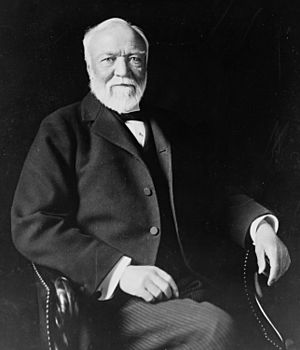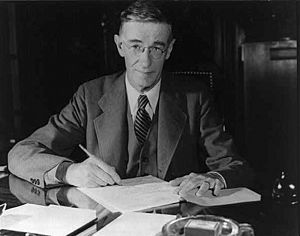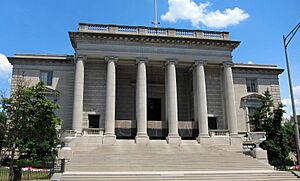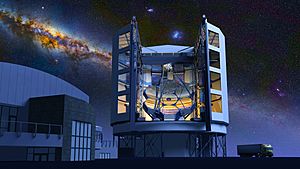Carnegie Institution for Science facts for kids
Carnegie Science, also known as the Carnegie Institution of Washington, is an organization that helps fund and perform scientific research in the United States. Its main office is in Washington, D.C.. As of mid-2020, the organization had a large fund of money, about $926.9 million, to support its work. In 2018, it spent $96.6 million on science programs and running the organization. The current president of Carnegie Science is John Mulchaey, who is an American astronomer.
Contents
What's in a Name?
Many different organizations were started by a generous person named Andrew Carnegie. More than 20 of these groups use his last name.
In 2024, the "Carnegie Institution for Science" officially changed its name to "Carnegie Science." People had been using "Carnegie Science" informally since 2007, when the name first changed from "Carnegie Institution of Washington."
A Look Back at Carnegie Science
Andrew Carnegie wanted to create an organization in Washington, D.C. that would "encourage investigation, research, and discovery" and "show the application of knowledge to the improvement of mankind." He said this on January 28, 1902.
During World War II, Vannevar Bush was the president of the Carnegie Institution. He convinced President Franklin D. Roosevelt to create a special committee to help with the nation's science efforts for the war. This committee was based at the Carnegie Institution's main building in Washington, D.C. From there, Bush helped manage many important projects, including the Manhattan Project, which developed the atomic bomb. Carnegie scientists also helped create the proximity fuze (a device that makes bombs explode near their target) and helped produce a lot of penicillin, a life-saving medicine.
Exploring Science at Carnegie
John Mulchaey is the 12th president of Carnegie Science. The organization has three main science divisions. These divisions are located on the East and West Coasts of the United States. They focus on life and environmental science, Earth and planetary science, and astronomy. These divisions are called Biosphere Sciences & Engineering, Earth & Planets Laboratory, and Observatories. Besides its facilities in the U.S., Carnegie Science also runs the Las Campanas Observatory in Chile.
Life and Environmental Sciences
Carnegie Science's research into life and the environment is now part of its Biosphere Sciences & Engineering Division. In the past, this research was done by departments like the Department of Embryology in Baltimore, Maryland, and the Department of Global Ecology in Palo Alto, California.
The former Department of Plant Biology started in 1903 as a desert laboratory. Scientists there studied plants in their natural homes. Over time, their research changed to focus on photosynthesis, which is how plants make their own food. This department also helps develop bioinformatics, which uses computers to understand biological information. Some very famous scientists who worked here include Nobel Prize winners Andrew Fire, Alfred Hershey, and Barbara McClintock.
Astronomy and Space
The Carnegie Science Observatories began in 1904 as the Mount Wilson Observatory. Andrew Carnegie provided money for the famous Hooker 100-inch telescope. On this telescope, scientist Edwin Hubble made a key discovery that led to finding the Andromeda Galaxy. As the city of Los Angeles grew closer to Mount Wilson, the daily operations there were moved in 1986.
Today, Carnegie astronomers work from offices in Pasadena, California. They also work from the Las Campanas Observatory in Chile, which was built in 1969. This observatory is in the Atacama Desert. It has two large 6.5-meter Magellan Telescopes, a 2.5-meter Irénée du Pont telescope, and a 1.0-meter Swope telescope.
Earth and Planets
In 2020, two departments, the Department of Terrestrial Magnetism and the Geophysical Lab, joined together. They became the Earth and Planets Laboratory. This lab is located on the organization's campus in Washington, D.C. The Laboratory is also a part of the NASA Astrobiology Institute.
The Department of Terrestrial Magnetism started in 1904. It used two ships to study the Earth's magnetic field around the world. The first ship, the Galilee, was used in 1905 but wasn't quite right. Later, the Carnegie was built in 1909. This ship completed seven trips to measure the Earth's magnetic field before it was destroyed by an explosion and fire.
Learning for Kids
In 1989, Carnegie President Maxine Singer started the Carnegie Academy for Science Education and First Light (CASE). This is a free Saturday science program for middle school students. The program teaches science through hands-on activities.
How Carnegie Science is Run
The main offices for Carnegie Science used to be at 1530 P Street, Northwest, in Washington, D.C. This building held the offices for the president, finance, publications, and fundraising. In 2020, this administrative building was sold to the government of Qatar to be used as their embassy.
Working with Others
Carnegie Science and Caltech have a formal partnership in Pasadena. The Carnegie Institution has also worked with several other organizations to build the Giant Magellan Telescope.
Leaders of Carnegie Science
Here are the people who have served as president of the Carnegie Institution for Science:
| No. | Image | President | Start | End | Notes |
|---|---|---|---|---|---|
| 1 |  |
Daniel Coit Gilman | 1902 | 1904 | |
| 2 |  |
Robert S. Woodward | 1904 | 1920 | |
| 3 |  |
John C. Merriam | 1921 | 1938 | |
| 4 |  |
Vannevar Bush | 1939 | 1955 | |
| 5 | Caryl P. Haskins | 1956 | 1971 | ||
| 6 |  |
Philip Abelson | 1971 | 1978 | |
| 7 | James D. Ebert | 1978 | 1987 | ||
| Acting | Edward E. David, Jr. | 1987 | 1988 | ||
| 8 |  |
Maxine F. Singer | 1988 | 2002 | |
| Acting | Michael E. Gellert | January 2003 | April 2003 | ||
| 9 | Richard Meserve | April 2003 | August 31, 2014 | ||
| 10 |  |
Matthew P. Scott | September 1, 2014 | December 31, 2017 | |
| Interim | John Mulchaey and Yixian Zheng | January 1, 2018 | July 1, 2018 | Co-Presidents | |
| 11 |  |
Eric D. Isaacs | July 2, 2018 | October 3, 2024 | |
| Interim | John Mulchaey | October 3, 2024 | November 22, 2024 | ||
| 12 | November 22, 2024 | present |
See also
 In Spanish: Instituto Carnegie para niños
In Spanish: Instituto Carnegie para niños
- Kurt Adelberger





